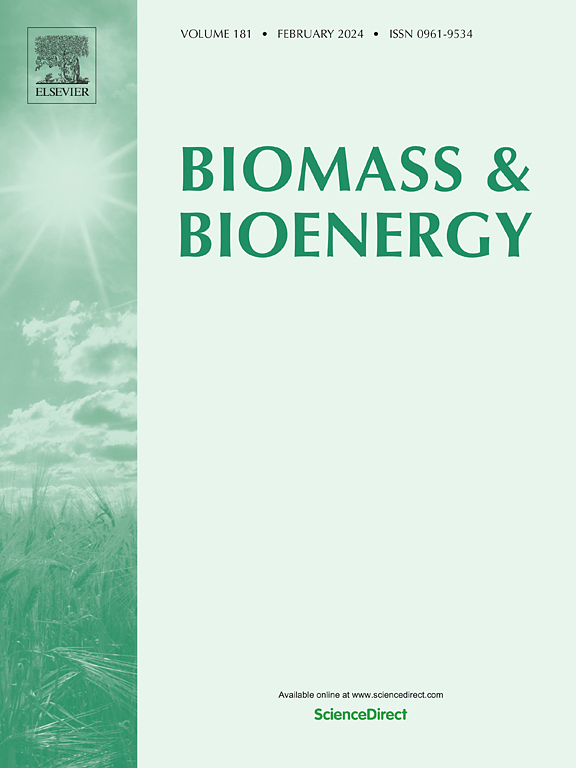绿色合成基于生物质废弃物的分层氮掺杂多孔活性炭材料作为高性能储能超级电容器
IF 5.8
2区 生物学
Q1 AGRICULTURAL ENGINEERING
引用次数: 0
摘要
采用适当的活化方法合成生物质碳基材料可以获得优异的电化学电容性能。在这项研究中,栗子壳被用作生物质衍生的碳前体,用于开发用于电化学储能应用的高性能电极材料。首先用氢氧化钠对板栗壳进行化学活化,得到掺n的NaOH-CS。然后,用氨水将氮原子掺杂到AC样品中,进一步改善了其表面性能。由于具有良好的孔隙结构、比表面积和N含量,掺N的NaOH-CS超级电容器材料在1 A/g时的电容性能达到625 F/g,比NaOH-CS材料提高了500%。不同的分析方法用于材料的表征。实验结果证实,n掺杂NaOH-CS超级电容器材料在5000个连续循环中稳定性为84.6%。在电流密度为1 a /g时,NaOH-CS-GCE//AC材料的能量密度为21.2 Wh/kg,功率密度为558 W/kg。当电流密度增加到8 A/g时,能量密度保持在22.0 Wh/kg,功率密度显著提高到4400w /kg。这些发现证明了从栗子壳中获得的生物质废料作为高性能电极材料的适用性。本文章由计算机程序翻译,如有差异,请以英文原文为准。

Green synthesis of hierarchical nitrogen-doped porous activated carbon material based on biomass waste for high-performance energy storage as supercapacitor
Superior electrochemical capacitance properties can be achieved with biomass-based carbon materials synthesized with appropriate activation methods. In this study, chestnut shells were employed as a biomass-derived carbon precursor for the development of high-performance electrode materials for electrochemical energy storage applications. The chestnut shells were first pyrolyzed through chemical activation with sodium hydroxide to produce N-doped NaOH-CS. Then, the surface properties were further improved by nitrogen (N) atom doping to the AC sample using ammonia. Due to the favorable pore structure, specific surface area, and N content, the N-doped NaOH-CS supercapacitor material exhibits excellent capacitive performance of 625 F/g at 1 A/g, representing a 500 % increase compared to the NaOH-CS material. Different analytical methods are used for the characterisation of the materials. Experimental results confirm that the N-doped NaOH-CS supercapacitor material shows a stability of 84.6 % over 5000 consecutive cycles. At a current density of 1 A/g, the NaOH-CS-GCE//AC material delivers an energy density of 21.2 Wh/kg with a power density of 558 W/kg. When the current density increases to 8 A/g, it maintains a comparable energy density of 22.0 Wh/kg while achieving a significantly higher power density of 4400 W/kg. These findings demonstrate the suitability of biomass waste obtained from chestnut shells for high-performance electrode materials.
求助全文
通过发布文献求助,成功后即可免费获取论文全文。
去求助
来源期刊

Biomass & Bioenergy
工程技术-能源与燃料
CiteScore
11.50
自引率
3.30%
发文量
258
审稿时长
60 days
期刊介绍:
Biomass & Bioenergy is an international journal publishing original research papers and short communications, review articles and case studies on biological resources, chemical and biological processes, and biomass products for new renewable sources of energy and materials.
The scope of the journal extends to the environmental, management and economic aspects of biomass and bioenergy.
Key areas covered by the journal:
• Biomass: sources, energy crop production processes, genetic improvements, composition. Please note that research on these biomass subjects must be linked directly to bioenergy generation.
• Biological Residues: residues/rests from agricultural production, forestry and plantations (palm, sugar etc), processing industries, and municipal sources (MSW). Papers on the use of biomass residues through innovative processes/technological novelty and/or consideration of feedstock/system sustainability (or unsustainability) are welcomed. However waste treatment processes and pollution control or mitigation which are only tangentially related to bioenergy are not in the scope of the journal, as they are more suited to publications in the environmental arena. Papers that describe conventional waste streams (ie well described in existing literature) that do not empirically address ''new'' added value from the process are not suitable for submission to the journal.
• Bioenergy Processes: fermentations, thermochemical conversions, liquid and gaseous fuels, and petrochemical substitutes
• Bioenergy Utilization: direct combustion, gasification, electricity production, chemical processes, and by-product remediation
• Biomass and the Environment: carbon cycle, the net energy efficiency of bioenergy systems, assessment of sustainability, and biodiversity issues.
 求助内容:
求助内容: 应助结果提醒方式:
应助结果提醒方式:


